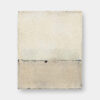Abstract Expressionism is considered one of the most important art movements of the 20th century. Created in the context of the Second World War and marked by the search for a new identity, this art movement broke with traditional ideas. It is known for its expressive, spontaneous and emotional, dynamic, and often chaotic paintings.
But Abstract Expressionism is also characterized by an interesting tension: on the one hand, we have the energetic and gestural works of Jackson Pollok, Franz Kline, and co., and on the other, the meditative, minimalist, and calm works of Agnes Martin, Ad Reinhardt, and others.
How could such a contrasting spectrum of expressions develop within a single artistic movement? After all, among art historians and critics, the prevailing opinion is that Minimal Art should be considered a counter-movement to the dramatic style of Abstract Expressionism. Nevertheless, many artists reject being classified as Minimalists.
The birth of a new form of expression
The beginnings of Abstract Expressionism can already be located in Europe: styles such as Cubism, Surrealism, and Constructivism had often altered the motif beyond recognition, thus already stimulating numerous debates in the art world. As a result of World War II, many talented European artists were forced to leave their homelands and emigrate to the United States. Many taught at art schools and thus exerted a strong influence on contemporary American artists and contributed to the development of the American art scene.
In New York in the late 1940s, a group of artists eventually began to search for a new form of expression. They questioned the fundamental meaning of art: what function does art have if it represents nothing? How can art be used to communicate emotions? Through these questions, painting functioned as a medium for existential aesthetic questions. The subconscious and intuitive movements of the artist were to be the focus.1
Abstract Expressionism had its peak in the late 1940s and early 1950s. One of the most important representatives was undoubtedly the American artist Jackson Pollock (1912 – 1956). He developed a unique technique, “action painting,” in which he dripped, flowed, and splattered paint directly from the tube onto the canvas. This technique allowed him to give free rein to his feelings and emotions on the canvas while making the painting process itself the central theme of his art.2 Franz Kline, also known for his dynamic and powerful compositions, believed in the idea of “gestural” painting, where the act of painting itself is considered an expression of energy and emotion.
On the other hand, however, artists such as Mark Rothko, Barnett Newman, Agnes Martin, and Ad Reinhardt developed a meditative, minimalist aesthetic. Their works also dealt with emotions and aspects of human consciousness, but in a reduced, less gestural way than those of the “action painters”. This so-called Color Field Painting developed out of Abstract Expressionism in America in the mid-1950s.3 Barnett Newman’s “Zips” – narrow, vertical lines dividing his colored canvases – are a good example of this reduced approach. Mark Rothko became best known for his large-scale, colorful rectangles.
Agnes Martin’s works often feature geometric compositions consisting of fine lines and delicate colors. However, this apparent simplicity and visual reduction belies the emotional depth and complexity of her works. Martin saw her art as a way to express an inner and spiritual experience, transporting the viewer into a world of calm and contemplation.
Painting is self-discovery. Every good artist paints what he is.
Jackson Pollock
This is also the case with Ad Reinhardt. He began to work more intensively with the color black around 1956. Minimalist at first glance, on closer inspection they reveal a subtle structure and depth that encourages the viewer to engage more intensively with the artwork.
Many of these works were eventually counted as part of the Minimal Art movement rather than Abstract Expressionism. But almost all artists vehemently rejected this. They felt that the term was inadequate to describe the complexity of their works and the underlying concepts and ideas. (I went into more detail on this topic in one of my recent essays, if you’re interested: Minimalism In Art: Is It Really That Simple?)
Minimalism in Abstract Expressionism – not a contradiction after all?
Thus, although contradictory at first glance, a minimalist aesthetic is not a contradiction within Abstract Expressionism. Newman, Reinhard, Martin, and Co. illustrate the diversity and multifaceted nature of the art movement and show how closely it is linked to Minimalism.
The various expressions are therefore to be seen today as part of a larger whole. The “Minimalists” within the artistic movement pursued similar ideas to their gestural companions but used different approaches and emphases. Their minimalist aesthetic is thus an alternative form of artistic expression that allows the essence of painting to be expressed in a different way.
The categorization of artists and movements in art history is often dependent on interpretations and the time in which they are considered. It shows us that it is not always clear and unambiguous, and perhaps not always necessary. Especially when it comes to the ideas and visions behind each work.
Further Reading
- https://www.schirn.de/magazin/kontext/2019/lee_krasner/
- https://www.wikiwand.com/en/JacksonPollock
- https://www.wikiwand.com/en/Colorfield
Title image made with Midjourney by Aesence


